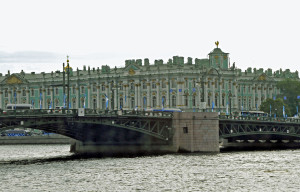
Winter Palace of the Hermitage (Photo by Don Knebel)
What is now the Hermitage began in 1764 when Russian Empress Catherine the Great bought 225 paintings, including 13 Rembrandts, from a Berlin art dealer. She soon acquired works by Rubens, Velazquez and other European masters and eventually owned almost 80,000 items, including cameos, engraved gems, coins and books. Catherine kept her treasures in a building named “the Hermitage” she erected adjacent the Winter Palace, the home of Russian czars. Catherine’s successors continued purchasing art treasures from around the world and displayed them in adjoining buildings. The three million items in the collection, now owned by the government, include “Benois Madonna,” Leonardo da Vinci’s earliest painting, “Crouching Boy,” a Michelangelo sculpture, Egyptian antiquities, Greek and Roman statuary, Chinese porcelain, ancient gold jewelry, and some of the most important works of modern artists. The most significant items are displayed in five connected buildings overlooking the Neva River, now all called “the Hermitage,” including the Winter Palace, whose magnificently furnished rooms are included in the Hermitage tour.
Since the time of Catherine the Great, cats have lived at the Hermitage, originally to control mice that might attack the priceless art. When the Romanov family and its dogs were evicted from the Winter Palace in 1917, later to be executed, the cats were left behind. Today, about 70 cats live in the Hermitage, looked after by three volunteer care-takers. The cats’ exploits are chronicled by their own press agent.
Especially during tourist season, the large crowds at the Hermitage permit only glances at its extraordinary treasures. But even a glance at some of the most important art in the world makes the visit unforgettable.
Comments are closed.